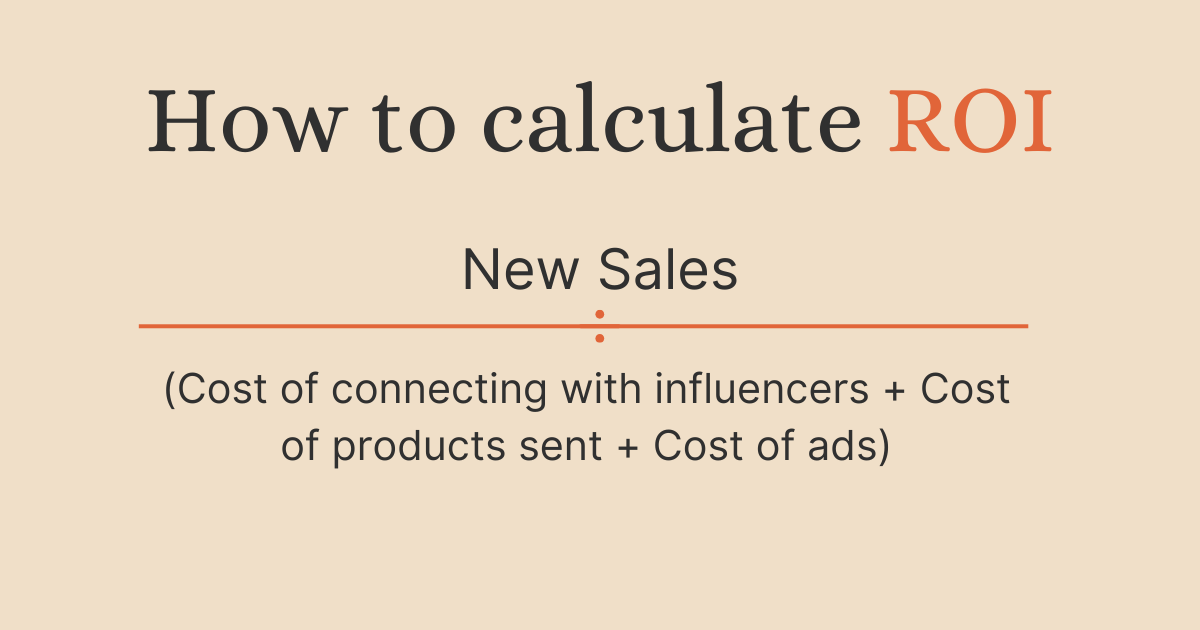Influencer Gifting: A Guide for Brands
At some point, marketers realized you can give people amazing products for free, and they’ll naturally recommend them. (Think, for example, of free samples.) Combine that with influencer marketing, and you end up with influencer gifting.
Influencer gifting is a highly effective strategy. 92% of marketers agree that sending gifts to influencers has increased their brand's visibility in the public eye. And that’s just one advantage.
There are several ways to approach product gifting:
- You can run gifting campaigns using free products to get content, brand awareness, and sales.
- You can send products without strings attached to generate goodwill and familiarity.
- You can launch new products by giving them to influencers who will promote them.
- You can get feedback on existing products and authentic reviews.
In this article, we’ll touch on these options–but we’ll mainly focus on the first one: running gifted collaborations. We’ll also discuss how brands get influencer gifting wrong so you know what to watch out for with your brand.
At the end of this guide, you’ll be equipped to create an influencer gifting strategy and get results.
What is influencer gifting?
When you give free products to influencers–whether or not you expect anything in return–that’s influencer gifting. Often, brands use influencer gifting as a way to run gifted collaborations.
What is a gifted collaboration? It’s a campaign where brands give free products to influencers in exchange for content (often UGC).
There are two types of gifted collabs: barter deals and no-strings-attached deals.
In a barter deal, you exchange products for content. It’s great if you need UGC, want to experiment with influencer marketing, or are doing a hard launch.
In no-strings-attached gifting, you send your product to influencers and don’t ask for anything back. This can get influencers familiar with your product before you ask them to promote it.
No-strings-attached influencer gifting is also sometimes called product seeding. More on that later.
Is influencer gifting still relevant in 2025?
The short answer is yes. Despite the rise of paid influencer marketing in recent years, gifted collaborations are still extremely popular.
Based on the results from our clients, we know why: 80% of the influencer collaborations on Social Cat are gifted campaigns, with an average engagement rate of 2.19%. For comparison, paid collaborations have lower engagement–around 1.94%.
You pay much less for better results with gifting.
However, not just any gifted collaboration is relevant–especially if it’s unnecessary or wasteful. When customers see brands lavishly gifting influencers, online criticism explodes, prompting writer Caroline Albro to ask, “Are we all [consumers] fed up with influencer gifting?”
However, gifted influencer marketing is an excellent option if you’re not going crazy with it and want to make genuine connections. Let’s examine the benefits of gifting influencers the right way. ⬇️
The benefits for brands
There are multiple benefits for brands, including:
- Savings. It costs less to run gifted collaborations than paid ones.
- Low risk. You can mitigate risk by seeing how they do with a gifted campaign. If it doesn’t go well, you move on.
- Building relationships and rapport. Influencer gifting is a great way to connect with influencers before you collaborate. If you give them free stuff, they can try it before you ask them to recommend it to their audience.
- Honest UGC. This is more valuable than paid endorsements.
The benefits for creators
Gifted collaborations aren’t one-sided deals. Creators benefit from influencer gifting in the following ways:
- Practice. Micro-influencers can’t demand the same prices as macro and mega-influencers. Gifted campaigns enable smaller creators to start benefitting sooner.
- Savings. If a brand gifts you something you’ll use, you’re saving money you would’ve spent buying it.
- Skills & portfolio building. Gifted campaigns are a great way to add brand collabs to your portfolio. You’ll also experience what it’s like to work with brands and build your communication skills.
- History and experience with specific brands. If your posts perform, you can follow up with brands about collaborating again. You never know if you might land your first brand ambassadorship deal.
- Future opportunities with other brands. Ask for reviews to recruit more clients. And you’ll be surprised how often word gets around when companies love working with you.
- Honesty and transparency. You test products and share your experience with your audience. You can be honest and help your audience make a good choice.
What type of collab is right for your campaign?
The type of influencer gifting that’s right for your brand will depend on your goals for the campaign.
Product seeding involves strategically giving your products to influencers. Essentially, you're “planting” your products to gain exposure, organic endorsements, and goodwill. This strategy is for influencer marketing and relationship-building.
PR seeding also involves giving influencers free products. However, instead of developing relationships with specific influencers, you send free products to launch a new product, ask for feedback, or build brand awareness. PR seeding is designed to increase the number of people who recognize your brand.
Content seeding refers to spreading your brand’s content across different channels. For example, you might hire influencers to create content about your brand for TikTok, Instagram, YouTube sponsorships, paid Facebook ads, Twitter, blogs, etc. Content seeding is a high-level marketing strategy that utilizes multiple channels.
Influencer gifting campaigns involve giving gifts to influencers in exchange for content and can include any of the previously mentioned goals. What sets them apart from “seeding” campaigns is that you negotiate with the influencer before you send the products. You know precisely what you’re getting in exchange for the free items.
Product seeding vs. gifting
So, when should you use influencer gifting over product seeding–and vice versa?
Use product seeding to:
- Form a relationship with a new-to-you influencer. Start the relationship by commenting on their posts and letting them know you LOVE their work.
- Increase your chances of creating organic buzz around your products. If you do enough product seeding, you will get a few responses.
Use influencer gifting to:
- Run a low-cost, strategic influencer marketing campaign. Many smaller creators want to practice making content for brands. You just need to know how to find micro-influencers in your niche.
- Create a low-risk way to test new creators. Do paid collaborations later if you like working together.
- Guarantee that you will receive content. If you want to guarantee that you receive something in return, negotiate before you send products.
What types of products are good for gifted collaborations?
Before you send a product, you need to know if the influencer is open to gifted collaborations and if they’re in your niche. Beyond that, make it an excellent experience.
It helps to ask yourself the following questions:
- Is my product high-quality and desirable to someone who already has many items in this category? Don’t cheap out and send them something unexciting.
- What makes my product special and unique? Would someone receiving it in the mail immediately recognize that?
- Does my product look good on camera? If not, it might not be a good candidate for influencer gifting. Sorry.
- Is my packaging appealing and fun to open?
- Can I make my gift even more appealing to an influencer? Affiliate deals or intangibles like access to exclusive experiences, events, or unreleased products can help.
- Would it be a better idea to send a gift box? This can help you boost brand awareness.
- What personal touches can I add? Do you know their favorite colors or features? CAn you add a personal note?
Here’s an influencer gifting note example you can use as a template:

How does influencer gifting work?
Here’s how to run gifting campaigns: Make a plan, write a brief, filter applicants, agree to a contract, send products, and finally–receive the deliverables. Let’s break down each of these steps.
Step 1: Make a plan
Every successful influencer campaign starts with a plan. Ask yourself these questions:
- What are my goals for this campaign? Put it in measurable terms. Generally, you’re looking for sales, exposure, conversions, or product feedback.
- Who am I trying to reach?
- What’s my budget?
- How much time do I have for this?
- How will I find the influencers I need?
You have four main options for finding influencers:
- DIY influencer outreach–free but time-consuming.
- An influencer search platform–inexpensive and saves time. Pick a platform that includes licensing and allows you to find influencers by niche.
- An influencer database–expensive and does not save time on outreach.
- Hire an influencer marketing agency–expensive but saves time. However, agencies don’t usually run gifted campaigns.
Your best option is an opt-in influencer search platform.
Social Cat is the only influencer platform that specializes in gifted influencer marketing. It’s a great choice if you want to find influencers eager to work on gifted campaigns.
Step 2: Write a brief
Now that you know your goals and how to find influencers, it’s time to write a brief. Here are the main pieces of information to include:
- The purpose of the campaign. For example, if you want sales or are hoping for UGC.
- Any unique aspects of this campaign: For example, if you’re hoping to encourage people to pick up multiple products for Christmas.
- The type of content you’re looking for: Instagram Reels, TikToks, etc.
- The video format you’re looking for: Reviews, Unboxing videos, etc.
- Main selling features of your brand.
It’s easy to write and post your brief on Social Cat.
- First, log into your account.
- Then, click “Create New Brief.”
- Follow the prompts to add details about your brief.
- Post it and wait for influencers to come to you.
Keep your briefs short. They’re easier to read and create more interest.
Step 3: Filter applicants
Don’t send free products to every influencer who applies to work with you. Choose the ones who:
- Have an audience that matches your target audience.
- Have an excellent portfolio.
- Don’t have fake followers. Before you work with an influencer, check for suspicious profiles.
- Get great reviews from previous clients.
- Have a decent engagement rate. If people don’t interact, they won’t buy.
Step 4: Write & sign a contract
Once you’ve found your influencers, it’s time to write a contract. Ensure your contract outlines your agreement and includes a due date. Social Cat has contract templates you can use.
Brands often skip this step for gifted campaigns. Do it anyway. A contract will:
- Get you on the same page and avoid headaches later.
- Protect you from legal action. Everyone knows exactly what they’re agreeing to.
- Help you get your stuff back if they don’t deliver.
Step 5: Send products
Once the details are ironed out, get the influencer’s address and send the products.
Then, wait. On Social Cat, our influencers must send content within 7 days of receiving the products. If you’re using a different platform, expect a longer turnaround time.
Step 6: Receive content from influencers & use it
Once the influencer posts about you, share the influencer’s post widely on your social media. This will boost it and strengthen your relationship.
Then, if you really want to see results from your gifted influencer campaign, use that content in ads. Paid ads are the most effective and inexpensive way to drive sales.
Influencer gifting campaign ROI
ROI is your return on investment. To calculate your ROI for gifting campaigns, you’ll need the following:
- The cost of finding influencers–the cost of your influencer platform, agency, or database.
- The manufacturing cost of the products you sent.
- The cost of ads.
- Because you’re running a gifted campaign, you don’t have to add influencer fees.
- How much money did you make in new sales due to this gifted collab?
Once you’ve collected those numbers, add up the first three–how much it costs to run this campaign. Then, divide the money you made by the number you got. That’s your ROI.

How to calculate ROI for gifted campaigns
Here’s how to optimize your gifting campaigns’ ROI:
- Pick a small number of the right influencers. The fewer influencer seeding kits you can send out, the better.
- Pick a low-cost recruitment tool like an opt-in influencer marketplace.
- Run ads with the content. Ads are more effective than one-off influencer posts.
Influencer gifting examples
Off The Farm’s scaled influencer gifting
Off The Farm couldn’t find influencers on Instagram willing to accept gifted campaigns at the start of their relationship. Most only wanted paid collaborations. So, they used Social Cat to discover influencers who loved gifted campaigns.
Goals for their campaigns: Streamlining their influencer discovery process, getting UGC content, and increasing sales
The results:
- A six-figure ROI
- Several viral Instagram reels
- Between 100-150 pieces of UGC
Mindful Remedies’ gifted collabs
Mindful Remedies was nervous about influencer gifting. What if influencers took custom-made products but never promoted them?
However, our vetted influencers helped them lay their worries aside.
Goals for the campaign: Brand awareness, conversions, and UGC.
The results:
- 179 pieces of UGC.
- Increased reach–their organic reach grew.
For more results like these, check out our customer success stories.
Misconceptions about gifted influencer campaigns
It’s crucial to have the right expectations when you’re running a gifted influencer campaign. So, in this section, we’ll explore the biggest misconceptions about influencer gifting and how to solve them.
Misconception #1: If you don’t get results, it’s the influencer’s fault.
If you’re a brand, it’s your job to research the influencer and communicate with them. Most brands are unhappy with the results of their gifted campaigns because their expectations are out of line or they fail to communicate what they want.
Misconception #2: Gifted campaigns take advantage of influencers.
Many smaller creators enjoy trying new products, receiving gifts, and being validated that they’re doing good work. If both parties agree to a gifted collaboration, there’s no issue.
Misconception #3: Influencers will ghost you after they get the free product.
While ghosting does happen, it’s most prevalent if you choose a DIY approach. Using an influencer gifting platform gives you tools to vet influencers and recourse if they ghost.
Misconception #4: Gifted campaigns don’t work.
Gifted campaigns tend to get results from a few overperforming accounts. Brands often try gifted collaborations, get frustrated when they don’t immediately overperform, then quit.
Misconception #5: If you send an influencer a gift, you’re entitled to exposure.
Unless you have a contract, you’re not entitled to content.
Best practices for running effective gifting campaigns
There are three major issues with an influencer gifting strategy:
- Finding influencers for the campaign.
- Not getting the expected results.
- Costs.
Here’s how to avoid them:
Use an opt-in influencer gifting platform
Using an opt-in influencer search platform helps you quickly find influencers. You also avoid the high costs of influencer databases and agencies.
For example, you can check their portfolio and reviews from other brands on Social Cat before you reach out.
Communicate early and often
Once the gift is out of your hands, you cannot control it. So, communicate what you hope to get from the trade before it happens.
Get it in writing. Sign a contract. That way, you have something to point back to if the influencer doesn’t deliver.
Know what you’re looking for
Take the time to review example videos and consider what you want.
Influencers can’t deliver something you haven’t communicated. Work with someone who makes the content you want to see your products in.
Choose an influencer gifting platform that includes licensing
To keep your campaign costs down, choose a platform that includes licensing and has no hidden fees. Small charges add up.
… In case you were wondering, Social Cat includes licensing, and our pricing covers all the features.
Compliance and regulation for gifted collaborations
The same rules that cover paid collaborations apply to gifted ones, too. After all, you’re “paying” the influencers for free products. Unfortunately, influencers don’t necessarily know these rules. It’s your responsibility as a brand to ensure they’re followed. You could end up in trouble otherwise.
According to the FTC:
- Advertisers must be honest about opinions. You can’t ask influencers to lie about your product.
- Any connections between influencers and brands must be CLEARLY disclosed—every time, including gifted campaigns.
- Give people realistic expectations about what they can achieve using your products. If an influencer has exceptional results–you must state the expected results.
We are not lawyers, so please consult one. Your legal team can advise you on how these rules apply to your situation.
What if influencers don’t post after receiving the gift?
Communicating beforehand can be the best way to avoid an influencer ghosting you after they receive the gift. Setting expectations is essential.
But what if you’ve already sent the product, and they haven’t posted?
All hope is not lost. Try this when you reach out:
- Assume the best. Often, influencers are busy or nervous about the project. Keep it civil.
- If there’s no deadline, work with them to set one.
- Offer to help with any talking points or questions they may have. If they’re having issues with your product, fix it right away.
- If they ghost you, keep reaching out and/or contact your platform to see what recourse they offer.
- If you have a contract, have your lawyer reach out. This mainly applies to high-cost items.
Frequently asked questions
1. Are gifted collaborations paid?
No, it’s bartering. In gifted collaborations, brands trade free products for content from influencers.
2. Are gifted collaborations good?
Yes. Gifted collaborations benefit brands and influencers. To make it successful, both parties must communicate their expectations upfront.
3. What is the difference between PR and gifted collabs?
Gifted collabs involve trading products for content to create UGC or sales. PR collabs involve sending influencers products and/or money for an endorsement.
4. Gifting vs. paid collaborations: Which is “best?”
Gifted collaborations are best if you have a tight budget or are trying something new. Paid collaborations are better once you’ve established relationships with influencers and know how to get results.
5. Do you need formal contracts or agreements for gifted items?
Yes. It’s easy and could save you later. A contract ensures everyone is on the same page and protects both parties in the event of a lawsuit.
6. How do brands ensure compliance with disclosure regulations?
Discuss disclosure regulations with the influencer. Make sure they disclose that you’ve given them products for free. Consult your lawyer for a boilerplate template for their captions, like “This item was gifted to me by [brand name]. All opinions are my own.”
7. How should creators disclose gifted collabs?
Mention that you received the items for free from the brand in your caption and content.
8. How to get great content from influencer gifting?
Choose influencers who know how to create great content. Then, communicate your expectations. Keep briefs as short as possible to allow for creativity.
9. How can brands leverage influencer-generated content after the campaign?
Use the content in ads. Repost it–with permission and credit, of course–on your brand’s social media profiles. Use it on product and sales pages on your website.
10. When and how often should we run gifting campaigns?
As often as you can. Gifting campaigns are most effective if you consistently get your product in front of your target audience.
11. What kind of licensing agreement do brands need for gifted collabs?
You need full licensing rights to use the content in ads, your company’s pages, and social media. Get it–it’s worth it.
Conclusion
As you can see, influencer gifting is a fantastic opportunity for brands and influencers. When done correctly, it increases consumer trust.
In this article, we’ve provided tips on how to do it right, from setting up your campaign for success to navigating legal disclosure requirements.
There’s only one thing left for you to do–go for it! Thousands of micro-influencers on Social Cat love working on gifted campaigns. Start a FREE trial today!
Table of content
- Influencer Gifting: A Guide for Brands
- What is influencer gifting?
- What type of collab is right for your campaign?
- What types of products are good for gifted collaborations?
- How does influencer gifting work?
- Influencer gifting campaign ROI
- Influencer gifting examples
- Misconceptions about gifted influencer campaigns
- Misconception #1: If you don’t get results, it’s the influencer’s fault.
- Misconception #2: Gifted campaigns take advantage of influencers.
- Misconception #3: Influencers will ghost you after they get the free product.
- Misconception #4: Gifted campaigns don’t work.
- Misconception #5: If you send an influencer a gift, you’re entitled to exposure.
- Best practices for running effective gifting campaigns
- Compliance and regulation for gifted collaborations
- What if influencers don’t post after receiving the gift?
- Frequently asked questions
- 1. Are gifted collaborations paid?
- 2. Are gifted collaborations good?
- 3. What is the difference between PR and gifted collabs?
- 4. Gifting vs. paid collaborations: Which is “best?”
- 5. Do you need formal contracts or agreements for gifted items?
- 6. How do brands ensure compliance with disclosure regulations?
- 7. How should creators disclose gifted collabs?
- 8. How to get great content from influencer gifting?
- 9. How can brands leverage influencer-generated content after the campaign?
- 10. When and how often should we run gifting campaigns?
- 11. What kind of licensing agreement do brands need for gifted collabs?
- Conclusion
Looking for influencers?
Table of content
- Influencer Gifting: A Guide for Brands
- What is influencer gifting?
- What type of collab is right for your campaign?
- What types of products are good for gifted collaborations?
- How does influencer gifting work?
- Influencer gifting campaign ROI
- Influencer gifting examples
- Misconceptions about gifted influencer campaigns
- Misconception #1: If you don’t get results, it’s the influencer’s fault.
- Misconception #2: Gifted campaigns take advantage of influencers.
- Misconception #3: Influencers will ghost you after they get the free product.
- Misconception #4: Gifted campaigns don’t work.
- Misconception #5: If you send an influencer a gift, you’re entitled to exposure.
- Best practices for running effective gifting campaigns
- Compliance and regulation for gifted collaborations
- What if influencers don’t post after receiving the gift?
- Frequently asked questions
- 1. Are gifted collaborations paid?
- 2. Are gifted collaborations good?
- 3. What is the difference between PR and gifted collabs?
- 4. Gifting vs. paid collaborations: Which is “best?”
- 5. Do you need formal contracts or agreements for gifted items?
- 6. How do brands ensure compliance with disclosure regulations?
- 7. How should creators disclose gifted collabs?
- 8. How to get great content from influencer gifting?
- 9. How can brands leverage influencer-generated content after the campaign?
- 10. When and how often should we run gifting campaigns?
- 11. What kind of licensing agreement do brands need for gifted collabs?
- Conclusion










